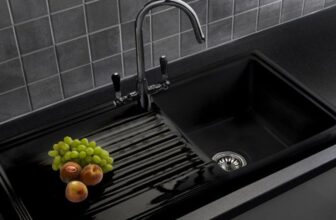Latex vs Enamel – What’s The Difference?
One of the most important elements of any DIY painting project is the research process and picking the right paint.
A good decision here can have a significant result on the final outcome of your paint job.
Of course, in any home improvement store, you’ll see that the paint section includes a large number of different options which can be a bit overwhelming, especially for those with less experience.
When choosing the paint, most homeowners, understandably, pay the most attention to the color.
However, the type of paint is just as important and can play a key role in the durability of the new coat covering your walls.
Most likely, you will end up choosing one of the two most commonly used types of paint – latex or enamel.
To help you make an informed decision, I’ll compare latex vs enamel paint and explain the differences between the two.
Table of Contents
What is Latex Paint?
Probably the most popular paint for home painting jobs, latex paint is a general-purpose product useful for both interior and exterior projects.
The name itself is a misnomer as this type of paint doesn’t contain any latex, but this designation refers more to its latex-like appearance in the can and aqueous dispersion.
Latex paint is actually water-based, so it dries fast and is more flexible than its oil-based counterparts.
It also owes a lot of its popularity to the fact that it’s relatively inexpensive and can be used on larger surfaces, such as walls or ceilings, although it can also be applied to furniture, doors, and similar home decor elements.
Due to its versatility, ability to adhere to different surfaces, and a variety of different finishes, latex paint can fit different rooms and different styles, and can even be used to paint kitchens and bathrooms, as it’s very easy to clean.
What is Enamel Paint?
Enamel paint is oil or solvent-based and is known for forming hard and glossy, shell-like surfaces once it dries out, which is how this type of paint got its name.
In general, enamel paint provides more durability than other types of paint.
Because of this. it’s often used for objects that require more protection in addition to a new coat of color.
However, since it’s fairly difficult to apply and doesn’t dry quickly.
Plus, as it’s oil-based, enamel paint works well to repel the water from the surface, so it’s frequently applied to objects that need waterproofing.
It also contains a higher level of toxins, has a strong odor, and creates a shell around the painted object, which is why it’s rarely used for larger surfaces, such as walls.
Enamel paint is often mixed with various chemicals to become even more versatile and gain additional properties, such as heat resistance.
Latex vs Enamel – What’s the Difference?
| Latex | Enamel | |
| Composition | Made from water-based emulsion and synthetic polymers | Made from oil-based resins and solvents |
| Cost | Generally less expensive than enamel | Generally more expensive than latex |
| Durability | Not as durable as enamel and may require multiple coats for coverage | Highly durable and resistant to chipping, fading, and stains |
| Uses | Ideal for indoor use on surfaces that don’t require high durability or chemical resistance | Ideal for outdoor use on surfaces that require high durability and chemical resistance |
| Application | Easy to apply, dries quickly, and easy to clean up with water | Harder to apply, slow drying time, and requires solvents for cleanup |
Even though they serve a similar basic purpose, comparing latex vs enamel will reveal numerous differences between these two types of paint which make each of them more suitable for certain kinds of painting projects.
I’ll go over the major distinctions between these two types of paint, so you can get an idea of which one will be a better fit for a particular paint job.
Paint Base
Probably the most significant difference between enamel and latex paints is in the paint base.
As I already mentioned, latex paints are water-based, while enamel painting products are typically oil-based.
This means that latex paints will dry faster and are more malleable.
Therefore, they’re more suitable for surfaces that may expand or require more flexibility, such as unprimed drywall or brick wall.
Enamel paint, on the other hand, is oil-based and dry slow, and provides a glossy and hard finish. So, it works better for harder and smaller surfaces.
Color
Both of these types of paint are available in a wide range of colors.
However, if you opt for latex paint, you’ll have fewer shades to choose from, which may make finding a perfect match a bit harder.
Still, as latex paint can be mixed to create new, custom colors, you can increase the range of available shades this way.
With enamel paint, you can pick between many colors, from classic white to deep black, with numerous shades available for each of them, so finding the perfect hue to match your project is easier.
As for the intensity of color, the advantage is on the side of latex paint.
As it contains more pigments than enamel paint, the color on the surface will be richer and more vibrant.
Also, latex paint is less likely to change and fade over time. This is particularly important with surfaces directly exposed to sunlight.
Finish
Another difference between these two types of paint is in the finish each of them provides.
Latex paint provides a more sophisticated finish which is why it’s the more popular option when it comes to interior walls and ceilings.
Depending on the variant of latex paint, you can achieve an eggshell, matte, or flat finish. However, it stains more easily and is harder to clean than an enamel finish.
Unlike latex, which provides a more rubbery and porous surface, when working with enamel paint, you’ll end up with a more glossy finish and a smooth and hard surface once the job is done.
If you choose this option, you can choose between satin, semi-gloss, and high-gloss finish.
Among other things, this means that enamel paint is better when you have to hide imperfections on various surfaces.
It also cleans better and is more resistant to scratches and chipping.
Durability
If you’re planning to paint a surface that is likely to see a lot of tear and wear, you want a paint that is more durable.
Between latex and enamel paint, the latter will provide more longevity and stay in a mint condition for a longer period.
This is especially true if you use these paints outside or in fluctuating climate conditions.
Latex paint is water-based and the drying process will be heavily influenced by weather conditions, which affects the finish and the quality of the paint.
On the other hand, enamel paint will be more resistant to fluctuating temperatures and provide similar results no matter how humid, cold, or hot the weather is.
However, enamel paint, like all oil-based paints, is more likely to turn yellow over time, unlike latex and other water-based paint which can keep the original color longer.
Drying Time
When planning a painting project, one of the most important factors to consider is drying time, as it will determine how long it will take to finish the job.
This is also an area where latex and enamel paint drastically differ one from the other.
The drying time will depend on weather conditions but, in most cases, enamel paint will be dry to touch in 6 to 8 hours.
However, you’ll have to wait 24 hours before applying the second coat.
Latex paint dries much faster and is dry to the touch in only 1 hour and ready for recoating in around 4 hours.
Note that faster drying time, while it shortens the period needed to finish the project, is not necessarily an advantage.
The longer drying time provides more space for manipulating the paint and applying a thicker and more even coat.
Safety
Any paint you may use contains chemicals that cause fumes which in higher amounts can cause headaches, breathing issues, or skin irritation.
This is why, when choosing the paint to use, you should also think about which one is safer for use. In general, latex paints are less toxic and safer than enamel and other oil-based paints.
Enamel paint features a higher VOC (volatile organic compounds) content, meaning that more of these dangerous compounds are released into the air as the paint dries.
This can lead to various health issues, such as nausea, headaches, or eye, nose, and throat irritation.
In addition, unlike latex paint, enamel products contain lead and mercury. Both of these highly toxic chemicals can cause serious problems if inhaled.
No matter which type of paint you use, always make sure that the room is well-ventilated and that the air can circulate freely.
Application and Tools
As it has better surface coverage, shorter drying time, and is more malleable, latex paint is easier to use than enamel.
Due to its high viscosity and thickness which makes it harder to spread, enamel paint is more difficult to apply.
There’s also a difference in the kind of tools you’ll need for the job when using one of these two types of paint.
When working with enamel paints, you achieve the best results if you use soft and flexible bristles, commonly found on natural hair brushes.
If you opt for synthetic and stiff brushes when applying enamel paint, you will likely have to deal with brush marks and uneven finish.
However, when using latex paint, you’ll achieve better results with synthetic brushes as the ones made of natural hair will soak up the water from the paint and become listless and useless.
Cleanup
Cleaning up after the job is done is another factor you have to consider when deciding which type of paint to purchase and use.
The cleaning process will be much easier if you’ve been using latex paint. As this type of paint is water-based, all you’ll need to clean up is water and some dish soap.
However, after painting with enamel paint, the cleanup will be a bit more complicated.
Cleaning the traditional oil-based enamel paint will require the use of paint thinners or mineral spirits.
The enamel resistance to water which is so useful for outdoor applications, here is a factor that contributes to the difficulty of the cleaning process.
Another issue is that paint thinner is hazardous, so you can’t just spill it in the toilet or sink, but have to dispose of it at a appropriate location.
Latex or Enamel – What is Used on Which Surface?
Another factor that will play a major role in solving the latex vs enamel dilemma is the type of surface you plan to paint.
Latex Paint
Typically, latex is used indoors and for projects where you need to cover larger surfaces.
It’s particularly suitable for painting surfaces in high-traffic areas that get frequent and intense usage.
As it dries rather quickly, it’s also a great fit for busy households or ones with young children. However, latex is not the perfect option in areas that are exposed to high moisture or a lot of heat.
Also, as it’s susceptible to peeling and chipping, you shouldn’t use it for surfaces that are expected to see a lot of wear and tear.
Here’s a list of surfaces the latex paint is great for:
- Walls
- Ceiling
- Siding
- Trim
- Window Frames
- Doors
- Indoor furniture and flooring
- Drywall
- Plaster
Enamel Paint
Enamel paint can be used for a wide range of surfaces, including wood, metal, aluminum, glass, ceramic, porcelain, and others.
It’s also great for outdoor use and surfaces in areas where you expect bad environmental conditions and frequent temperature fluctuations.
Due to its durability and water-resistance properties, the enamel is also a good choice for kitchens and bathrooms.
Plus, this type of paint is often used by hobbyists, modelers, and artists for decorative and artistic projects.
Here’s a short overview of uses where enamel paint is a great option:
- Doors
- Outdoor furniture
- Window trim and sashes
- Porches
- Cabinets
- Decks and floors
- Kitchen Appliances
- BBQ grills
- Washers and driers
Conclusion
Before you start your DIY painting project, you should carefully consider all the requirements of that particular job.
This will help you choose the right type of paint, as not every paint will produce the optional result on various surfaces.
Latex paint is a great choice for larger projects, provides better coverage, and is easier to apply. It’s also safer for use and will dry more quickly.
All this makes sit perfect for indoor use. Enamel paint should be your choice when working with surfaces that require better and more durable protection, especially if exposed to weather elements.
It is, however, more difficult to use and clean up, as well as more toxic than enamel paint.
In any case, once you understand the differences between these two types of paints, you can confidently make the right decision and pick the best paint based on your needs.



















































































